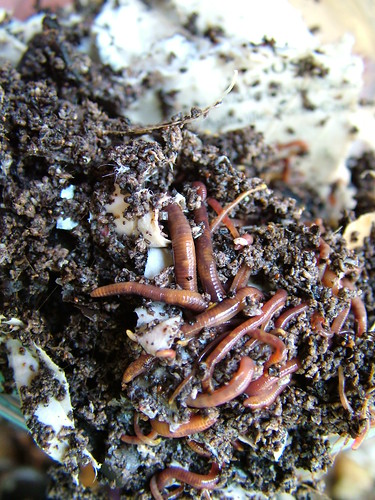
Basically, all you need to do is acquire some red wrigglers (Eisenia fetida) and about ten minutes. According to Toolbox for Sustainable City Living, these worms are special because they do really well in compost as opposed to soil, and they secrete a substance that kills pathogenic bacteria. So when a nasty bacteria touches it's skin, the bacteria dies.
I posted a wanted listing on Freecycle and the next day a sweet woman had a container of worms waiting on her porch for me. Someone had given some to her, and they had reproduced. "It feels good to pay it forward!" she chirped as I was leaving. (Thanks gift economics!)
 So here's how you do this thing:
So here's how you do this thing:Get a container. It can be made of plastic or wood. I had these left over from when I started passively composting last year and they got too small. I'm sure something suitable could be easily dumpstered.
Drill some ventilation holes. However you see fit. The book reccomended a couple of large holes with screens over them. I used a drill bit and made a bunch of them then duct-taped some cheesecloth over them.
Layer the bottom with some bedding. This can be shredded newspaper, cardboard, dry leaves, or something similar. (This will have to be replaced at some point when the worms eventually eat it.)
Add your compost and worms. Voila!


3 comments:
neat read! i wanted to learn more about methane harvesting (from compost) and usage. apparently it's all the rage in rural china where the grid doesn't exist?
this reminded me and i hope to maybe follow through with an idea some day. thanks!
oh...i wanna be a fellow blogger:
chapmanit.blogspot.com (my techie tutorials) and
listendammit.blogspot.com (supposedly non techie stuff)
that does look easy. I thought you needed a way to catch and drain the liquid from the bottom?
Just my 2 cents, but you might want to find a way to be able to separate the worms from the compost when it's ready to use. Otherwise you are going to have quite a time picking worms out of there (obviously you want to hold on to the worms so you can keep composting)I have a 3 tier system that allows the worms to leave the completed compost and head for greener pastures (or more food!)Good luck!
Post a Comment